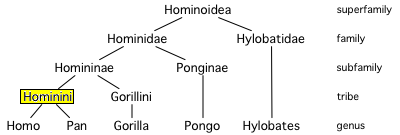Homo (genus)
| Homo | ||||||||||||||||||
|---|---|---|---|---|---|---|---|---|---|---|---|---|---|---|---|---|---|---|
| Scientific classification | ||||||||||||||||||
| ||||||||||||||||||
|
Homo sapiens sapiens |
Homo is the genus that includes modern humans and their close extinct relatives, such as Homo habilis and Homo erectus. Members of Homo are distinguished from other hominids by an erect posture, a large cranium, two-footed gait, fully opposable thumbs, and well-developed tool-making ability.
The oldest fossils of Homo trace to at least 2.3 to 2.5 million years ago (Smithsonian 2007a). All species except Homo sapiens (modern humans) are extinct. Homo neanderthalensis, traditionally considered the last surviving relative, died out about 30,000 years ago, though dates as recent as 24,000 years ago have been proposed.
The word homo, the Latin name for "man" in the original sense of "human being," or "person," was chosen originally by Carolus Linnaeus in his classification system. The word "human" is from Latin humanus, an adjective cognate to homo.
Overall classification
Primate taxonomy has undergone a number of revisions in recent years. For some time, Homo sapiens were the only extant species in the family Hominidae, while the great apes (chimpanzee, gorilla, and orangutans) were placed in a separate family Pongidae. Thus, human beings and their extinct relatives were separate from the other apes at the family level. Today, however, it is common to place these great apes and humans and their extinct relatives together in Hominidae. There are even other taxonomic schemes, such as placing extant and extinct chimpanzees and gorillas in the family Panidae, orangutans in the historical group Pongidae, and humans alone in Hominidae.
Based on the scheme currently popular, the chimpanzees, gorillas, and humans are together in the subfamily Homininae, and chimpanzees and humans are together in the tribe Hominini. Furthermore, humans and their extinct relatives (eg. Australopithecines, Neanderthals)—those more closely related to humans than the other great apes—are placed together in the subtribe Hominina. Within the subtribe Hominina, the genus Homo, and by inference all bipedal apes, is found.
It is thought that humans shared a common ancestor with chimpanzees as recently as five to seven million years ago
Close extinct genera include Paranthropus and Australopithecus, whose evolutionary branch split off from the proto-Homo line some 5 million years ago.
Members of the genus Homo
In modern taxonomy, Homo sapiens is the only extant (living) species of its genus, Homo. However, there were other Homo species, all of which are now extinct. While some of these other species might have been ancestors of H. sapiens, many were likely "cousins," having speciated away from the ancestral line. There is not yet a consensus as to which of these groups should count as separate species and which as subspecies. In some cases, this is due to the paucity of fossils; in other cases, it is due to the slight differences used to classify species in the Homo genus.
- †Homo habilis (Handy Man)
- †Homo rudolfensis (Rudolf Man)
- †Homo ergaster (Working Man)
- †Homo erectus (Upright Man)
- †Homo floresiensis? (questionable whether really a species)(Flores Man—discovered 2003)
- †Homo heidelbergensis (Heidelberg Man)
- †Homo neanderthalensis (Neanderthal Man)
- †Homo rhodesiensis (Rhodesia Man)
- Homo sapiens
- Homo sapiens sapiens (Wise Man; modern humans)
There is ongoing debate over whether '"Neanderthal" should be classified as a separate species, Homo neanderthalensis, or as a subspecies of H. sapiens, labeled as Homo sapiens neanderthalensis. The classification as a subspecies was popular in the 1970s and 1980s, but today many list them as separate species (Smithsonian 2007b).
Homo erectus ("upright man") lived from about 1.8 million years ago (mya) to 50-70,000 years ago. However, often the early phase, from 1.8 to 1.25 (or 1.6) mya, is considered to be a separate species, Homo ergaster, or as a subspecies of erectus, Homo erectus ergaster (Mayr 2001).
A minority of zoologists consider that the two species of chimpanzees (usually treated in the genus Pan), and maybe the gorillas (usually treated in the genus Gorilla) should also be included in the genus Homo based on genetic similarities. Most scientists argue that chimpanzees and gorillas have too many anatomical differences between themselves and humans to be part of Homo. Of course, this considers only anatomical and genetic differences, rather than a comprehensive view that includes social, psychological, religious, and other factors, in which the gap between humans and the other great apes is very large.
ReferencesISBN links support NWE through referral fees
- Mayr, E. 2001. What evolution is. New York: Basic Books. ISBN 0465044255.
- Serre, D., A. Langaney, M. Chech, M. Teschler-Nicola, M. Paunovic, et al. 2004. No evidence of Neandertal mtDNA contribution to early modern humans. PLoS Biol 2(3): e57. Retrieved March 6, 2007.
- Smithsonian National Museum of Natural History. 2007a. The origin of the genus Homo. Smithsonian Institution. Retrieved March 8, 2007.
- Smithsonian National Museum of Natural History. 2007b. Homo neanderthalensis. Smithsonian Institution. Retrieved March 4, 2007.
Credits
New World Encyclopedia writers and editors rewrote and completed the Wikipedia article in accordance with New World Encyclopedia standards. This article abides by terms of the Creative Commons CC-by-sa 3.0 License (CC-by-sa), which may be used and disseminated with proper attribution. Credit is due under the terms of this license that can reference both the New World Encyclopedia contributors and the selfless volunteer contributors of the Wikimedia Foundation. To cite this article click here for a list of acceptable citing formats.The history of earlier contributions by wikipedians is accessible to researchers here:
The history of this article since it was imported to New World Encyclopedia:
Note: Some restrictions may apply to use of individual images which are separately licensed.
